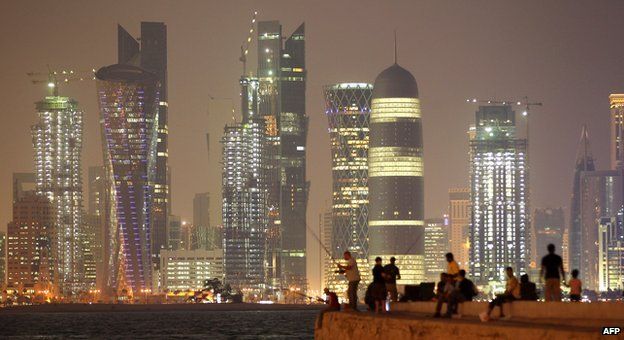UN says carbon cuts too slow to curb dangerous warming
- Published

A report by the UN says global attempts to curb emissions of CO2 are falling well short of what is needed to stem dangerous climate change.
The UN's Environment Programme says greenhouse gases are 14% above where they need to be in 2020 for temperature rises this century to remain below 2C.
The authors say this target is still technically achievable.
But the opportunity is likely to be lost without swift action by governments, they argue.
Negotiators will meet in Doha, Qatar for the UN Climate Change Conference (COP18) next week to resume talks aimed at securing a global deal on climate by 2015.
The Emissions Gap Report 2012 has been compiled by 55 scientists from 20 countries. It says that without action greenhouse gases in the atmosphere will be the equivalent 58 gigatonnes of carbon dioxide per year by 2020.
That's around 14 gigatonnes above the level that scientists have said is needed to keep temperature rises this century below the targeted level of 2C.
Even if the most ambitious pledges from countries to cut emissions are honoured, the gap is likely to be eight gigatonnes, an increase of two gigatonnes on last year's estimates.
"Eight is a big number," says Dr Joseph Alcamo, chief scientist of the United Nations Environment Programme (UNEP), "that's about the total greenhouse gas emissions of the entire industrial sector in the whole world right now."
The United Nations Environment Programme (Unep) says the increase in the levels of emissions in this year's report is due to projected economic growth in some developing countries and the removal of some emissions cuts that were counted twice.
"The report provides a sobering assessment of the gulf between ambition and reality," says Achim Steiner, the executive director of Unep.
Mr Steiner says that bridging the gap remains technically possible from large reductions in power generation and transport.
The report also highlights examples of relatively inexpensive actions that have been effective in curbing emissions at national level. These include higher performance standards for vehicles and appliances, and economic incentives to reduce deforestation. Many of these actions have been taken for economic reasons but are having the added benefit of reducing emissions.
Lead author, Dr Monica Araya says it is crucial that this approach continues.
"If we want politicians to endorse these policies they have to be able to go out there and sell them on the basis of the benefits they create for their people and not just for the planet."
Critical talks
The report is meant to inform negotiators at the COP18 climate meeting that begins in Doha next week.
According to Christiana Figueres, who will lead the talks on behalf of the United Nations Framework Convention on Climate Change, it should help governments identify how ambitions can be raised.
"It is a reminder that time is running out but that the technical means and the policy tools to allow the world to stay below a maximum 2C are still available to governments and societies," she said.
The UNEP report follows on from a new analysis by the World Meteorological Organisation that says the amount of greenhouse gases in the atmosphere reached a record high in 2011. It suggests that CO2 has now reached concentrations of 390.9 parts per million, or 140% of the pre-industrial levels of 280ppm.
The impact of these gases has been significant, says the WMO, causing a 30% increase of the warming effect on the climate between 1990 and 2011.
- Published20 November 2012
- Published10 October 2012
- Published8 October 2012
- Published29 June 2012